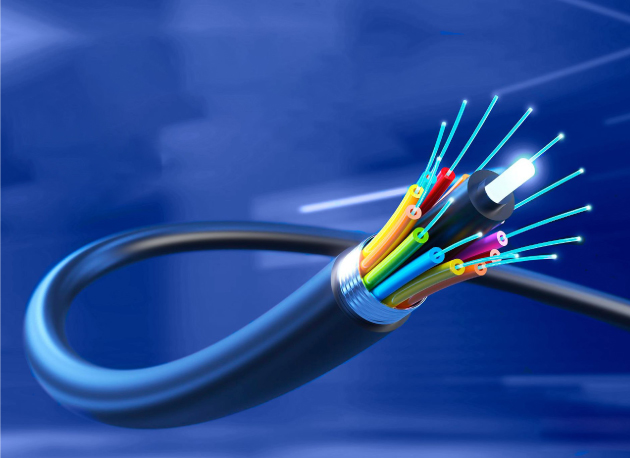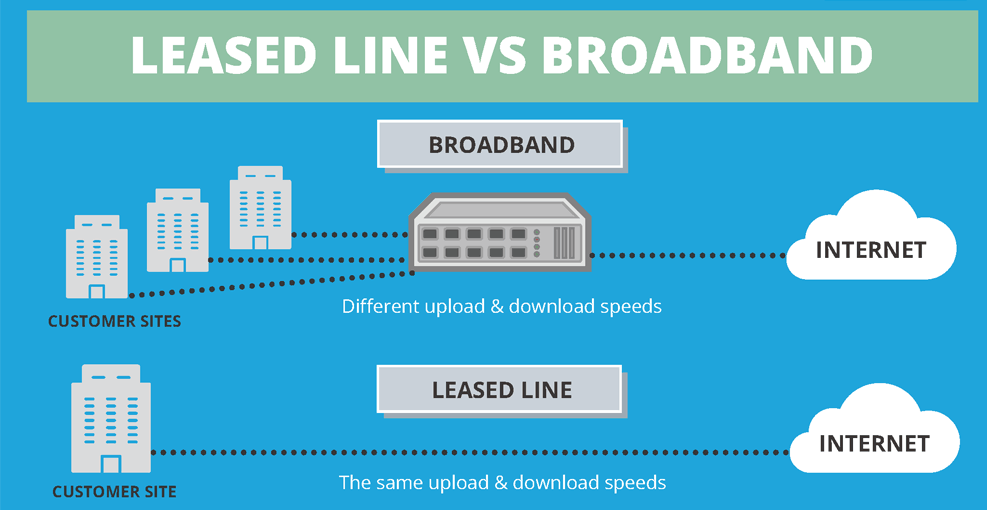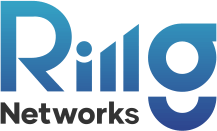Blog
Internet Leased Line - Know Everything About It

In today’s digital age, businesses and organizations heavily rely on the internet for their day-to-day operations. Whether it’s sending and receiving emails, accessing cloud-based applications, conducting online transactions, or communicating with customers, a fast and reliable internet connection is essential. One of the solutions that many enterprises opt for is an Internet Leased Line.
An Internet Leased Line is a dedicated, point-to-point data connection that provides exclusive access to the internet. Unlike traditional broadband connections, which are typically shared among multiple users, a leased line offers a private and dedicated channel that ensures consistent and high-speed connectivity. It is commonly used by businesses that require a robust internet connection with guaranteed bandwidth and low latency.
The leased line is called “leased” because it is rented from a service provider or telecommunications company. The provider establishes a physical connection between the customer’s premises and their network infrastructure, ensuring a direct and uncontended link to the internet. This dedicated connection bypasses the public internet, resulting in increased security and faster data transfer rates.
What Is Internet Leased Line
An Internet Leased Line is a dedicated, high-speed, and private data connection that provides exclusive access to the internet. It is a type of telecommunications service offered by service providers or telecommunications companies to businesses and organizations that require a reliable and high-performance internet connection.
Unlike traditional broadband connections, which are shared among multiple users, a leased line offers a dedicated channel that is not shared with other customers.
This ensures consistent and uninterrupted connectivity, regardless of the network traffic or usage patterns of other users. Leased lines are commonly used by businesses that rely on a stable and robust internet connection to conduct their daily operations.
The term “leased” in Internet Leased Line refers to the fact that the connection is rented or leased from the service provider. The service provider establishes a physical connection between the customer’s premises and their network infrastructure.
This connection can be implemented using various technologies, such as fiber-optic cables, Ethernet, or point-to-point microwave links, depending on the availability and requirements of the customer’s location.
What Are The Types Of Leased Line

- T1/E1 Leased Line: T1 and E1 leased lines are digital transmission lines that provide dedicated point-to-point connectivity. T1 lines offer a data rate of 1.544 Mbps, while E1 lines provide a data rate of 2.048 Mbps. These types of leased lines are commonly used for small to medium-sized businesses and can support voice and data traffic.
- T3/E3 Leased Line: T3 and E3 leased lines offer higher bandwidth compared to T1/E1 lines. T3 lines have a data rate of 44.736 Mbps, while E3 lines provide a data rate of 34.368 Mbps. These lines are suitable for larger organizations or those with high data transfer requirements, such as data centers or enterprises with extensive network infrastructure.
- Ethernet Leased Line: Ethernet leased lines utilize Ethernet technology to provide dedicated connectivity. These lines offer higher bandwidth options and are widely used for connecting local area networks (LANs) or wide area networks (WANs). Ethernet leased lines can range from a few Mbps to several Gbps, depending on the specific needs of the customer.
- Fiber Leased Line: Fiber leased lines utilize fiber-optic cables to provide high-speed connectivity. Fiber-optic technology offers exceptional data transfer rates and is known for its reliability and security. Fiber leased lines are commonly used for businesses that require high bandwidth and low latency, such as multimedia companies, research institutions, or financial institutions.
- Microwave Leased Line: Microwave leased lines use wireless microwave technology to establish a point-to-point connection. This type of leased line is often used in areas where laying physical cables is challenging or costly. Microwave leased lines can provide reliable connectivity with lower latency, making them suitable for remote locations or areas with limited infrastructure.
- Satellite Leased Line: Satellite leased lines utilize satellite communication to establish a connection between the customer’s premises and the service provider’s network. This type of leased line is particularly useful in remote or rural areas where other forms of connectivity may be limited. Satellite leased lines can provide reliable connectivity but may have higher latency due to the long distance signals must travel.
It’s important to note that the availability of these types of leased lines may vary depending on the location and infrastructure of the Leased Line service provider. Organizations should consult with service providers to determine the most suitable leased line option based on their specific needs, location, and budget.
How does a Leased Line work?
A leased line works by establishing a dedicated, point-to-point connection between the customer’s premises and the service provider’s network infrastructure. Here is a brief explanation of how a leased line works:
- Connection Establishment: The process begins with the customer contacting a service provider to request a leased line connection. The service provider assesses the customer’s location and connectivity requirements to determine the feasibility of providing the leased line service.
- Physical Connection: Once the feasibility is established, the service provider installs the necessary physical infrastructure to establish the leased line connection. This may involve laying fiber-optic cables, Ethernet connections, or setting up microwave or satellite communication links, depending on the specific type of leased line and the customer’s location.
- Dedicated Channel: Unlike standard internet connections that are shared among multiple users, a leased line offers a dedicated channel exclusively for the customer. This means that the bandwidth and resources of the leased line are not shared with other users, ensuring consistent and reliable connectivity.
- Bandwidth Allocation: The service provider allocates a specific bandwidth to the customer based on their requirements. Leased lines typically provide symmetrical bandwidth, meaning the upload and download speeds are the same. This is important for businesses that require a balanced data transfer for activities such as hosting servers, video conferencing, or transferring large files.
- Data Transfer: Once the leased line connection is established, data can be transferred between the customer’s premises and the service provider’s network infrastructure. The data travels through the dedicated channel of the leased line, ensuring high-speed and low-latency connectivity.
- Service Level Agreements (SLAs): To guarantee the quality and reliability of the leased line service, service providers often offer Service Level Agreements (SLAs). SLAs outline the agreed-upon terms and conditions, including uptime guarantees, response times for troubleshooting, and fault resolution. These SLAs provide assurance to the customer regarding the service quality and support they can expect from the service provider.
- Private and Secure Connection: A leased line provides a private and secure connection for the customer. Since the connection is dedicated and does not traverse the public internet, it is less susceptible to external threats and provides enhanced security for transmitting sensitive data.
Overall, a leased line operates by establishing a dedicated connection between the customer and the service provider. This exclusive and reliable connection ensures consistent and high-speed data transfer, making it an ideal choice for businesses and organizations that require a robust and dependable internet connection.
There are several key features and benefits associated with Internet Leased Lines:
Dedicated Bandwidth: Leased lines offer symmetrical bandwidth, meaning the upload and download speeds are the same. This is crucial for businesses that rely on activities such as video conferencing, cloud computing, or hosting websites and servers.
Reliable Connectivity: Since the connection is exclusive to the customer, there is no sharing of bandwidth with other users. This ensures a consistent and reliable connection, free from fluctuations in speed or performance during peak usage times.
Service Level Agreements (SLAs): Leased line providers typically offer SLAs that guarantee a certain level of service, including uptime, response times for troubleshooting, and fault resolution. This allows businesses to have peace of mind knowing that any issues will be promptly addressed.
Scalability: Leased lines can be easily scaled up or down based on the organization’s requirements. If a business experiences growth and requires additional bandwidth, the service provider can adjust the connection accordingly.
Enhanced Security: Leased lines provide a higher level of security compared to standard broadband connections. Since the connection is private and doesn’t traverse the public internet, it is less susceptible to external threats such as hacking, data breaches, or Distributed Denial of Service (DDoS) attacks.
Quality of Service (QoS): Leased lines often offer QoS features that prioritize critical data traffic, ensuring that important applications and services receive the necessary bandwidth and latency requirements.
Internet Leased Lines are commonly used by businesses that rely heavily on uninterrupted internet access, such as large corporations, financial institutions, e-commerce platforms, IT companies, and call centers. They provide the necessary infrastructure to support critical operations and ensure optimal performance for online services.
In conclusion, an Internet Leased Line offers a dedicated and reliable internet connection with guaranteed bandwidth, low latency, and enhanced security. It enables businesses to operate efficiently, communicate effectively, and deliver high-quality online services. With its numerous advantages, it has become an indispensable solution for organizations that require a robust and dependable internet connection.
Who can use internet leased line
Leased lines are used by a wide range of businesses and organizations that require a reliable, high-speed, and dedicated internet connection. Here are some of the key industries and entities that commonly use leased lines:
Large Enterprises: Large corporations and multinational companies often rely on leased lines to support their extensive network infrastructure. These organizations require a stable and high-bandwidth connection to facilitate communication, data transfer, and access to cloud-based services across their various branches and offices.
Financial Institutions: Banks, insurance companies, and other financial institutions rely heavily on secure and uninterrupted connectivity to carry out critical financial transactions and data exchange. Leased lines provide the necessary speed, security, and reliability to support these operations, ensuring that sensitive customer information and financial data are transmitted safely.
E-commerce Platforms: Online businesses and e-commerce platforms that rely on real-time inventory management, payment processing, and order fulfillment require a dedicated and high-speed connection. Leased lines offer the necessary bandwidth to handle the large volumes of data associated with online transactions and customer interactions.
Media and Entertainment: Media companies, broadcasting organizations, and content providers often require high-bandwidth connections to transmit large multimedia files, stream high-definition video, and support live broadcasts. Leased lines enable them to deliver content efficiently and maintain a seamless user experience.
Research and Educational Institutions: Universities, research institutes, and educational institutions need reliable connectivity to support their academic and research activities. Leased lines provide the necessary bandwidth for collaboration, access to online databases and libraries, and sharing of large research data sets.
Call Centers: Call centers heavily rely on uninterrupted connectivity to handle customer calls, provide customer support, and process transactions. Leased lines offer low-latency connections, ensuring clear voice quality and minimizing delays during customer interactions.
Government and Public Sector: Government organizations, including local and national government bodies, utilize leased lines to support their various operations. These may include secure data transfer, communication between government agencies, public service delivery, and information exchange.
Healthcare Facilities: Hospitals, clinics, and healthcare institutions require fast and secure connectivity for accessing electronic medical records, transmitting medical images, telemedicine services, and sharing patient information securely. Leased lines ensure reliable and high-bandwidth connections, critical for delivering quality healthcare services.
It is worth noting that while leased lines are commonly used by larger organizations with high connectivity needs, small and medium-sized enterprises (SMEs) that rely heavily on internet connectivity for their business operations may also opt for leased lines if they require guaranteed bandwidth, low latency, and enhanced security.
In summary, leased lines are utilized by various industries and organizations that demand a reliable, dedicated, and high-performance internet connection. The advantages of leased lines, such as symmetrical bandwidth, enhanced security, and service level agreements, make them a suitable choice for businesses and institutions that require consistent and robust connectivity for their operations.
What should you check with a leased line service provider?
When choosing a leased line service provider, it is crucial to evaluate several factors to ensure you select the right provider that meets your business needs. Here are some key aspects to check with a leased line service provider:
Service Availability: Determine if the leased line service is available in your area. Check with the provider to confirm coverage and inquire about any limitations or restrictions that may exist in your location. It’s important to ensure that the provider can deliver the leased line service to your premises.
Bandwidth Options: Understand the range of bandwidth options offered by the service provider. Assess your current and future bandwidth requirements to ensure that the provider can accommodate your needs. Inquire about the scalability options available, as your business may require increased bandwidth as it grows.
Service Level Agreements (SLAs): Review the SLAs offered by the service provider. SLAs outline the performance guarantees, uptime commitments, response times for troubleshooting, and fault resolution procedures. Ensure that the SLAs align with your business requirements and expectations.
Support and Customer Service: Evaluate the level of support and customer service provided by the leased line service provider. Check their responsiveness, availability, and the channels through which support can be accessed. Prompt and reliable support is crucial in case of service disruptions or technical issues.
Network Redundancy: Inquire about the network redundancy measures implemented by the provider. Redundancy ensures that there are backup systems or alternative routes in place to maintain connectivity in the event of network failures or outages. Ask about their network architecture and how they ensure high availability.
Security Measures: Discuss the security measures implemented by the service provider to protect your leased line connection. Inquire about encryption options, firewall capabilities, and any additional security features they offer to safeguard your data and network.
Installation and Lead Time: Check the estimated lead time for installing the leased line connection. Understand the installation process, any potential disruptions during the installation, and the level of involvement required from your end. Discuss the installation timeline to ensure it aligns with your business needs and timelines.
Pricing and Contracts: Understand the pricing structure and contract terms offered by the service provider. Inquire about any hidden fees, installation charges, or recurring costs associated with the leased line service. Evaluate the contract length and termination clauses to ensure they align with your business flexibility.
Customer References and Reviews: Seek customer references or read reviews about the service provider to get insights into their reputation and customer satisfaction. This can help you gauge the reliability and quality of their service based on real experiences from other businesses.
Future Technology Upgrades: Inquire about the provider’s plans for future technology upgrades and improvements. Leased line technology continues to evolve, and you want to ensure that the provider can support future enhancements and offer the latest connectivity options as they become available.
By thoroughly checking these aspects with a leased line service provider, you can make an informed decision and choose a provider that offers reliable connectivity, robust support, and meets your specific business requirements.



